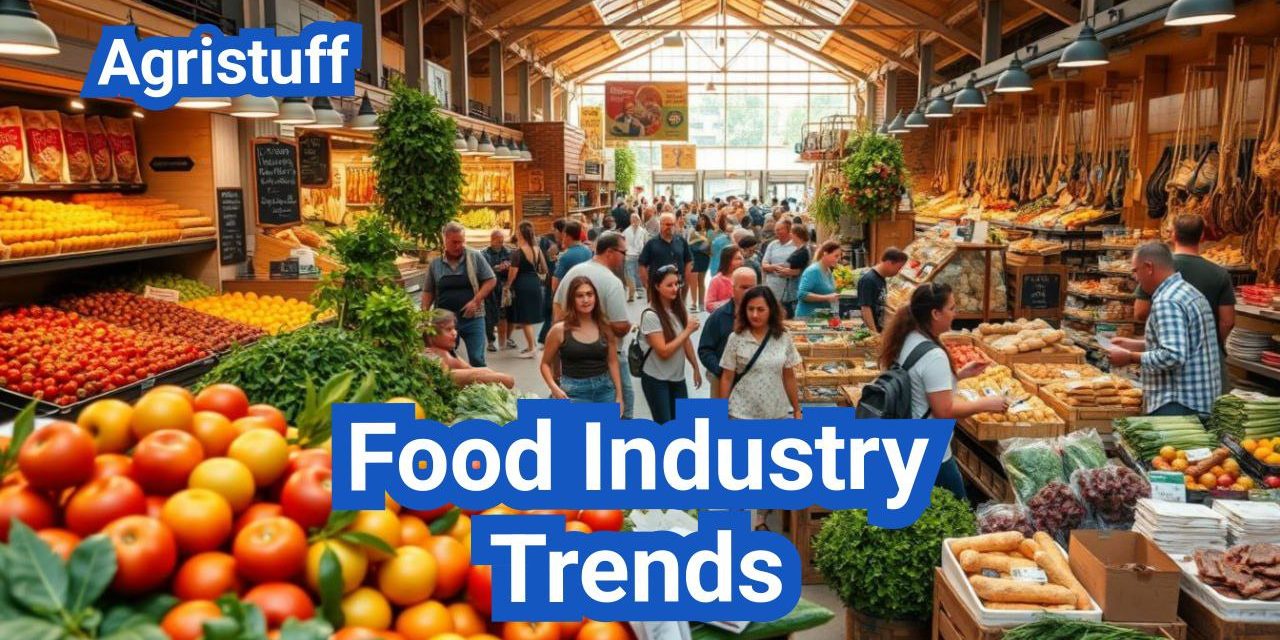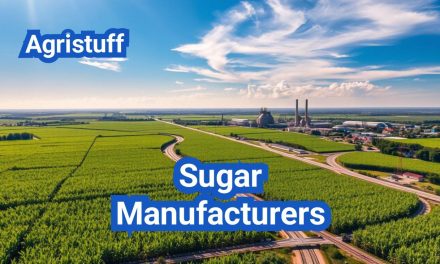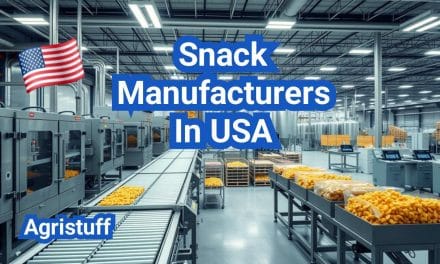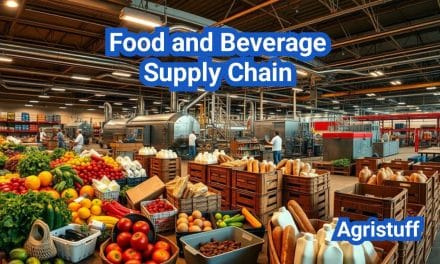The U.S. food manufacturing is a vital component of the nation’s economy, with $1.9 trillion in annual sales and employing 1.6 million workers. This significant sector is constantly evolving, driven by changing consumer preferences and advancements in technology.
The latest updates in the U.S. food market ( Food Industry Trends ) indicate a shift towards sustainability and healthier eating options. As consumers become more environmentally conscious, manufacturers are adapting by introducing eco-friendly packaging and sourcing ingredients responsibly.
Key Takeaways
- The U.S. food manufacturing sector is a significant economic contributor.
- Consumer preferences are driving changes in the industry.
- Sustainability and health trends are on the rise.
- Technological advancements are shaping the industry’s future.
- Eco-friendly packaging is becoming increasingly popular.
The Current State of the U.S. Food Industry
The U.S. food industry is at a crossroads, balancing traditional practices with innovative approaches to meet evolving consumer demands. With a vast landscape of over 21,000 companies nationwide, the sector is characterized by its diversity and complexity.
Key Market Statistics and Growth Projections
The U.S. food processing sector has seen a 1.75% rise in employment over the past year, indicating a steady growth trajectory. Average reported sales stand at $1.9 trillion, underscoring the industry’s significant economic impact. Growth projections suggest continued expansion, driven by consumer demand for new and innovative products.
Major Players and Market Share Distribution
The U.S. food industry is dominated by a mix of large multinational corporations and smaller, niche players. Major companies have a significant market share, but there’s also room for smaller businesses to innovate and capture specific consumer segments.
Post-Pandemic Recovery and Adaptation
The COVID-19 pandemic has accelerated changes in consumer behavior, forcing the industry to adapt rapidly. Companies have invested in digital transformation, enhancing their online presence and delivery capabilities to meet the new demand landscape.
As the industry continues to recover and adapt, understanding these shifts will be crucial for stakeholders to navigate the evolving market effectively.
Understanding Modern Consumer Behavior

Understanding the intricacies of modern consumer behavior is essential for businesses to stay competitive in the U.S. food market. The landscape of consumer preferences is continually evolving, influenced by factors such as demographics, personal values, and economic conditions.
Shifting Demographics and Their Impact
The demographic makeup of the U.S. consumer market is undergoing significant changes, with implications for the food industry. For instance, the growing diversity of the population is leading to increased demand for a wider variety of ethnic foods. Food manufacturers are responding by expanding their product lines to cater to these new tastes, thereby opening up new market opportunities.
The Values-Driven Consumer
Today’s consumers are more values-driven than ever, with many making purchasing decisions based on their personal beliefs and values. This trend is particularly evident in the food sector, where consumers are increasingly seeking products that are not only tasty but also sustainable and ethically sourced. Companies that align their brand values with those of their consumers are likely to build stronger brand loyalty.
Price Sensitivity vs. Premium Experiences
Consumers are exhibiting a dual behavior when it comes to pricing – they are both price-sensitive and willing to pay a premium for unique experiences. This dichotomy presents a challenge for food businesses, which must balance the need to offer value for money with the desire to provide premium products and experiences.
Budget-Conscious Shopping Strategies
To cater to budget-conscious consumers, food retailers are adopting strategies such as private label products, which offer good value for money without compromising on quality. The growth in demand for private label products indicates that consumers are looking for affordable alternatives without sacrificing quality.
Luxury Food Category Growth
On the other end of the spectrum, the luxury food category is also experiencing growth, driven by consumers seeking “crazy creations” for the “ultimate indulgent experience.” This trend highlights the willingness of consumers to pay a premium for unique and high-quality food experiences.
In conclusion, understanding modern consumer behavior in the U.S. food industry requires a nuanced approach, taking into account shifting demographics, the rise of the values-driven consumer, and the balance between price sensitivity and the demand for premium experiences. By catering to these diverse consumer needs, food businesses can position themselves for success in a competitive market.
How to Identify Emerging Food Industry Trends
Identifying emerging trends is crucial for businesses to remain competitive in the U.S. food industry. As consumer preferences continue to evolve, companies must stay ahead of the curve to capitalize on new opportunities.
Research Methods and Resources
To identify emerging trends, businesses rely on a variety of research methods and resources. One key approach is leveraging market research reports from firms like Innova Market Insights, which provide valuable insights into consumer behavior and market shifts.
- Industry reports and publications
- Social listening tools to gauge consumer sentiment
- Consumer surveys and focus groups
Analyzing Consumer Data Effectively
Analyzing consumer data is critical for understanding emerging trends. Companies are increasingly using AI and data analytics to uncover patterns in consumer behavior, from flavor preferences to purchasing habits.
Effective data analysis involves:
- Collecting data from various sources, including social media and sales data
- Using advanced analytics tools to identify trends
- Interpreting data to inform business decisions
Trend Forecasting Techniques
Trend forecasting involves using various techniques to predict future trends. Two key methods include:
Social Listening Tools
Social listening tools allow businesses to monitor consumer conversations on social media, providing insights into emerging preferences and trends.
Industry Reports and Publications
Industry reports and publications offer analysis on market shifts and consumer behavior, helping businesses stay informed about the latest developments.
| Trend Forecasting Technique | Description | Benefits |
|---|---|---|
| Social Listening | Monitoring consumer conversations on social media | Real-time insights into consumer preferences |
| Industry Reports | Analysis of market shifts and consumer behavior | In-depth understanding of market trends |
By combining these research methods, data analysis, and trend forecasting techniques, businesses in the food industry can effectively identify emerging trends and stay competitive in a rapidly changing market.
Technology Revolutionizing Food Production

Technological innovations are revolutionizing the way food is produced, processed, and consumed. The food production landscape is witnessing a significant shift with the integration of automation, AI, and other cutting-edge technologies.
Automation and AI in Manufacturing
Automation is helping to address labor shortages in the food industry, with robots performing repetitive tasks and improving overall quality. AI-powered systems are being used to optimize production processes, predict maintenance needs, and enhance product consistency.
Key Benefits of Automation in Food Production:
- Increased efficiency and productivity
- Improved product quality and consistency
- Reduced labor costs and improved worker safety
Food Tech Innovations and Investments
Food tech innovations, such as AI-powered flavor innovation and precision agriculture, are on the rise. Investments in these technologies are expected to grow significantly in the coming years, driving further advancements in food production.
| Technology | Application | Benefits |
|---|---|---|
| AI-powered flavor innovation | Developing new flavors and products | Increased product variety, improved consumer satisfaction |
| Precision agriculture | Optimizing crop yields and reducing waste | Improved resource efficiency, reduced environmental impact |
Smart Kitchens and Connected Appliances
The rise of smart kitchens and connected appliances is changing the way consumers interact with food. These technologies enable real-time monitoring, automated cooking, and personalized nutrition planning.
Implementation Strategies for Businesses
To successfully implement these technologies, businesses should focus on:
- Assessing their current production processes and identifying areas for improvement
- Investing in employee training to ensure effective use of new technologies
- Collaborating with technology providers to develop customized solutions
By embracing these technological advancements, food production businesses can improve efficiency, reduce costs, and meet evolving consumer demands.
Sustainability: The New Standard
Sustainability is no longer just a buzzword; it’s a critical component of the food industry’s future. As consumers increasingly demand eco-friendly products, companies are adapting to meet these new expectations.
Reducing Food Waste Initiatives | Food Industry Trends
One of the significant areas of focus is reducing food waste. According to the USDA, approximately 30-40% of the food supply in the United States is wasted. Companies are implementing various strategies to minimize waste, such as improving supply chain efficiency and donating unsold food to charities.
For instance, some retailers are using data analytics to predict demand more accurately, thereby reducing the likelihood of overstocking perishable goods.
Sustainable Packaging Solutions | Food Industry Trends
Another crucial aspect is sustainable packaging. Consumers are driving demand for recyclable, compostable, and lightweight packaging. Companies are responding by innovating and adopting eco-friendly packaging materials.
- Biodegradable packaging made from plant-based materials
- Reusable containers and bags
- Minimalist packaging designs that reduce material usage
Carbon Footprint Reduction Strategies | Food Industry Trends
Reducing the carbon footprint of food production and distribution is also a priority. This involves optimizing logistics, using renewable energy sources, and implementing energy-efficient manufacturing processes.
Measuring Environmental Impact | Food Industry Trends
To effectively reduce their carbon footprint, companies must first measure their environmental impact. This involves conducting thorough assessments of their operations, from sourcing to delivery.
Implementing Carbon-Neutral Practices | Food Industry Trends
Once the impact is assessed, companies can implement carbon-neutral practices. This might include investing in renewable energy projects, offsetting emissions, and adopting sustainable agricultural practices.
By embracing sustainability, the food industry not only contributes to a healthier planet but also enhances its brand reputation and complies with increasingly stringent environmental regulations.
Health and Wellness Product Development

Consumers are increasingly seeking products that offer health benefits beyond basic nutrition. This shift is driving innovation in the food industry, particularly in the development of health and wellness products.
Functional Foods and Nutraceuticals | Food Industry Trends
Functional foods and nutraceuticals are at the forefront of this trend. These products are designed to provide additional health benefits, such as improved heart health or enhanced cognitive function. The market for functional foods is growing rapidly, with consumers willing to pay a premium for products that offer specific health benefits.
Clean Label Movement | Food Industry Trends
The clean label movement is another significant trend in health and wellness product development. Consumers are increasingly demanding products with simpler, more natural ingredients. This trend is driving manufacturers to reformulate products, reducing the use of artificial additives and preservatives.
Addressing Dietary Restrictions and Allergies | Food Industry Trends
Addressing dietary restrictions and allergies is also a critical aspect of health and wellness product development. Manufacturers are developing products that cater to various dietary needs, such as gluten-free, vegan, and dairy-free options.
Formulation Challenges and Solutions | Food Industry Trends
Formulating products that meet these new demands can be challenging. Manufacturers must balance consumer expectations with the need for products that are both safe and effective. Some of the formulation challenges include maintaining product taste and texture while using alternative ingredients.
| Challenge | Solution |
|---|---|
| Maintaining taste and texture | Using natural sweeteners and alternative thickeners |
| Ensuring allergen safety | Implementing strict manufacturing protocols and testing |
| Meeting clean label expectations | Using simpler, more natural ingredients |
By understanding these challenges and developing effective solutions, manufacturers can create health and wellness products that meet consumer demands while ensuring product safety and efficacy.
The Rise of Plant-Based and Alternative Proteins

The rise of plant-based and alternative proteins is reshaping the U.S. food industry landscape. Over the last 15 years, plant-based diets have seen a significant surge in popularity, with a growth rate of 300%. This trend is driven by consumers’ increasing awareness of health, environmental, and ethical issues associated with traditional animal-based protein sources.
Market Growth and Consumer Adoption | Food Industry Trends
The market for plant-based and alternative proteins is experiencing rapid growth. Consumers are adopting these products for various reasons, including dietary restrictions, health concerns, and environmental sustainability. This shift is reflected in the increasing availability of plant-based products in mainstream retail channels.
Key drivers of market growth include:
- Increasing consumer awareness of the health benefits associated with plant-based diets
- Growing concern about the environmental impact of animal agriculture
- Rising demand for products that cater to flexitarian, vegetarian, and vegan lifestyles
Innovation in Meat Alternatives | Food Industry Trends
Innovation is a critical factor in the growth of the plant-based and alternative protein market. Companies are investing heavily in research and development to create products that mimic the taste, texture, and nutritional profile of traditional meat products. Advances in food technology have enabled the creation of sophisticated meat alternatives that appeal to a broad consumer base.
Cultivated Meat: The Next Frontier | Food Industry Trends
Cultivated meat, also known as lab-grown or clean meat, represents the next frontier in alternative proteins. This technology involves growing animal cells in a controlled environment to produce meat products without the need for animal slaughter. Cultivated meat has the potential to offer significant environmental and animal welfare benefits.
Regulatory Hurdles and Opportunities | Food Industry Trends
The development and commercialization of cultivated meat face regulatory challenges. Key regulatory issues include:
- Classification and labeling of cultivated meat products
- Safety assessment and inspection protocols
- Approval processes for new production facilities
Addressing these regulatory hurdles will be crucial for the successful integration of cultivated meat into the mainstream market.
Supply Chain Resilience and Transparency

Supply chain resilience and transparency are emerging as critical factors in the U.S. food industry’s future success. As the industry continues to navigate the complexities of global supply chains, companies are focusing on strategies to enhance resilience and transparency.
Blockchain for Food Traceability | Food Industry Trends
The use of blockchain technology is revolutionizing food traceability. By creating an immutable record of transactions, blockchain enables companies to track the origin, processing, and distribution of food products. This not only improves transparency but also helps in identifying and addressing potential contamination sources more efficiently.
“The integration of blockchain in food supply chains is a game-changer, offering unparalleled transparency and trust.” –
Industry Expert
Companies like Walmart and IBM are already leveraging blockchain to enhance their supply chain operations. For instance, Walmart’s use of blockchain has enabled it to track produce from farms to stores, significantly reducing the time taken to identify and recall contaminated produce.
Localizing Supply Networks | Food Industry Trends
Localizing supply networks is another strategy being adopted to improve supply chain resilience. By reducing dependence on distant suppliers, companies can mitigate risks associated with transportation disruptions and geopolitical issues.
| Benefits | Impact |
|---|---|
| Reduced transportation costs | Lower carbon footprint |
| Improved supply chain agility | Faster response to disruptions |
| Enhanced local economic support | Community development |
Addressing Labor Shortages | Food Industry Trends
Labor shortages continue to challenge the food industry. To address this, companies are turning to automation and technology to supplement their workforce.
Automation vs. Human Workforce Balance | Food Industry Trends
While automation can enhance efficiency, it’s crucial to strike a balance between automated processes and human labor. This balance ensures that the industry can adapt to changing demands while maintaining a skilled workforce.
The future of the U.S. food industry depends on its ability to build resilient and transparent supply chains. By embracing technologies like blockchain, localizing supply networks, and addressing labor shortages, companies can navigate the complexities of the modern food supply chain.
Navigating Regulatory Changes and Compliance

Navigating the complex landscape of regulatory changes is crucial for companies in the U.S. food industry to ensure compliance. The regulatory environment is constantly evolving, with updates from the FDA, changes in labeling requirements, and a heightened focus on food safety modernization.
FDA Updates and Implications | Food Industry Trends
The FDA regularly introduces new regulations to enhance food safety and consumer protection. Recent updates include stricter guidelines on food additives and contaminants. Companies must stay informed about these changes to avoid non-compliance, which can result in significant fines and reputational damage.
Labeling Requirements Evolution | Food Industry Trends
Labeling requirements are becoming increasingly stringent, with a focus on transparency and consumer information. The FDA has introduced new rules on nutrition labeling, including the disclosure of added sugars and the use of “percent daily value” (%DV) to help consumers make informed choices. Ensuring compliance with these labeling requirements is critical for food manufacturers.
Food Safety Modernization | Food Industry Trends
The Food Safety Modernization Act (FSMA) represents a significant shift towards preventive controls in food production. It emphasizes the importance of identifying and mitigating potential hazards in the food supply chain. Companies are required to implement robust food safety plans, conduct regular inspections, and maintain detailed records.
Compliance Checklist for Manufacturers | Food Industry Trends
- Stay updated on FDA regulations and guidelines.
- Implement preventive controls as per FSMA requirements.
- Ensure accurate and compliant labeling.
- Conduct regular audits and maintain detailed records.
- Train staff on compliance and food safety protocols.
By following this checklist and staying informed about regulatory changes, food manufacturers can ensure compliance and maintain a competitive edge in the market.
Major Food Industry Trends Reshaping Marketing

The food industry’s marketing landscape is being transformed by trends that prioritize consumer engagement. As consumers become more discerning, food companies are adapting their marketing strategies to better connect with their audience.
Social Media’s Influence on Food Choices | Food Industry Trends
Social media platforms have become crucial in influencing food choices. Companies are leveraging these platforms to showcase their products, share behind-the-scenes content, and engage with consumers directly. Instagrammable moments and influencer partnerships are key strategies used to capture the attention of potential customers.
The visual nature of platforms like Instagram and TikTok makes them ideal for showcasing food products. Brands are creating engaging content that not only highlights their products but also tells a story, making the brand more relatable to its audience.
Storytelling and Brand Authenticity | Food Industry Trends
Storytelling has emerged as a powerful tool in food marketing. By sharing the story behind their products, companies can create an emotional connection with consumers. This narrative can include the origin of ingredients, the manufacturing process, or the brand’s commitment to sustainability.
Brand authenticity is crucial in building trust with consumers. Companies that are transparent about their practices and values are more likely to resonate with modern consumers who prioritize authenticity.
Personalization and Direct-to-Consumer Models | Food Industry Trends
Personalization is becoming increasingly important in food marketing. Companies are using data to understand consumer preferences and tailor their marketing efforts accordingly. This can include personalized product recommendations, targeted advertising, and customized promotions.
Direct-to-consumer models are also gaining traction, allowing companies to sell their products directly to consumers through their websites or subscription services. This approach not only enhances customer experience but also provides valuable data for further personalization.
Case Studies of Successful Campaigns | Food Industry Trends
Several food companies have successfully implemented these trends in their marketing campaigns. For instance, a popular snack brand used social media storytelling to highlight its sustainable packaging, resulting in increased brand loyalty. Another company utilized personalization in its email marketing, achieving a significant increase in sales.
These examples demonstrate how embracing the latest trends in food marketing can lead to substantial benefits for companies. By staying ahead of the curve and adapting to consumer preferences, food businesses can thrive in a competitive market.
E-commerce and Digital Transformation

As consumers increasingly turn to online platforms, the food industry is undergoing a digital transformation. This shift is driven by changing consumer behaviors and technological advancements.
Accelerating Online Grocery Shopping | Food Industry Trends
The COVID-19 pandemic has significantly accelerated the growth of online grocery shopping. Consumers are seeking convenient and safe ways to purchase food, driving the demand for e-commerce platforms.
Key statistics:
- Online grocery sales have seen a substantial increase.
- Consumers are increasingly using digital channels for grocery shopping.
Subscription Models and Meal Kits | Food Industry Trends
Subscription models and meal kits have gained popularity, offering consumers convenience and personalized experiences. These services provide regular deliveries of fresh ingredients and pre-planned meals.
Benefits include:
- Convenience and time-saving.
- Personalized meal planning.
Last-Mile Delivery Innovations | Food Industry Trends
Last-mile delivery is a critical component of e-commerce in the food industry. Companies are innovating to reduce delivery times and costs.
Innovations include:
- Use of drones and autonomous vehicles.
- Partnerships with local delivery services.
Technology Integration Guide | Food Industry Trends
To successfully integrate technology, businesses should:
- Assess their current e-commerce capabilities.
- Invest in user-friendly online platforms.
- Implement efficient logistics and delivery systems.
By embracing e-commerce and digital transformation, food industry businesses can stay competitive and meet evolving consumer demands.
Restaurant and Foodservice Evolution

With technological advancements, restaurants and foodservices are revolutionizing their operations. The industry is witnessing a significant shift towards more efficient, customer-centric models.
Ghost Kitchens and Virtual Brands | Food Industry Trends
The rise of ghost kitchens and virtual brands is transforming the way restaurants operate. Ghost kitchens, also known as dark kitchens, are commercial cooking spaces that prepare food solely for delivery or pickup, without dine-in facilities. Virtual brands, on the other hand, are restaurant concepts that exist solely online, often operating out of these ghost kitchens.
Key Benefits of Ghost Kitchens:
- Reduced operational costs
- Increased flexibility in menu offerings
- Enhanced focus on delivery and takeout services
Technology Integration in Dining | Food Industry Trends
Technology is being increasingly integrated into the dining experience, enhancing customer convenience and operational efficiency. From digital menus to contactless payments, technology is revolutionizing the way restaurants interact with customers.
Examples of Technology Integration:
| Technology | Description | Benefits |
|---|---|---|
| Digital Menus | Electronic menus accessible via QR codes or mobile apps | Reduced wait times, easy updates |
| Contactless Payments | Payment systems that allow customers to pay without physical contact | Increased safety, faster checkout |
Reimagining the Customer Experience | Food Industry Trends
To stay competitive, restaurants are reimagining the customer experience, focusing on personalization, convenience, and unique dining experiences.
Adaptation Strategies for Traditional Establishments | Food Industry Trends
Traditional restaurants are adapting by embracing technology, enhancing their online presence, and offering innovative services such as meal kits and subscription models.
Adaptation Strategies:
- Investing in digital marketing and social media
- Implementing online ordering and delivery systems
- Offering personalized dining experiences
Preparing for the Future of Food
The U.S. food industry is on the cusp of a significant transformation, driven by evolving consumer behaviors, technological advancements, and shifting market dynamics. To navigate this changing landscape, companies must be proactive in their preparation for the future of the food industry.
Key trends such as the rise of plant-based alternatives, technological innovations in food production, and the growing importance of sustainability will continue to shape the industry. Businesses that adapt to these changes and prioritize consumer needs will be best positioned for success.
Effective preparation involves not only understanding current trends but also anticipating future developments. By investing in research and development, embracing digital transformation, and focusing on sustainability, companies can stay ahead of the curve and thrive in a rapidly evolving market.
As the food industry continues to evolve, companies that are agile, innovative, and consumer-centric will be the ones to lead the way in shaping the future of food.
FAQ
What are the current trends in the U.S. food industry?
The U.S. food industry is experiencing a shift towards sustainability, health and wellness, and digital transformation, with consumers increasingly demanding plant-based and alternative proteins, functional foods, and online grocery shopping options.
How is the food industry adapting to post-pandemic recovery?
The food industry is adapting to post-pandemic recovery by implementing new technology, such as automation and AI, and changing consumer behavior, including a rise in online ordering and delivery.
What is driving the demand for sustainable packaging?
The demand for sustainable packaging is driven by consumers’ increasing awareness of environmental issues and their desire to reduce food waste and carbon footprint.
How are food companies using technology to improve production?
Food companies are leveraging food tech innovations, such as precision agriculture and smart kitchens, to improve production efficiency and reduce costs.
What is the impact of social media on food choices?
Social media has a significant influence on food choices, with consumers often discovering new products and brands through online platforms and influencer marketing.
How are restaurants and foodservice providers evolving?
Restaurants and foodservice providers are evolving by adopting ghost kitchens and virtual brands, integrating technology into their operations, and reimagining the customer experience.
What are the key regulatory changes in the food industry?
Key regulatory changes in the food industry include FDA updates, labeling requirements, and food safety modernization efforts, which require companies to adapt and comply.
How can businesses identify emerging trends in the food industry?
Businesses can identify emerging trends by conducting market research, analyzing consumer data, and using trend forecasting techniques to stay ahead of the curve.
What is the role of blockchain in food traceability?
Blockchain technology is being used to enhance food traceability, improve supply chain transparency, and ensure food safety by tracking products from origin to consumption.
How are companies addressing labor shortages in the food industry?
Companies are addressing labor shortages by implementing automation, investing in training programs, and adopting innovative staffing solutions to attract and retain workers.
Conclusion of: Food Industry Trends in USA
Why food industry trends matter right now
The U.S. marketplace is resetting after years of shocks, and understanding food industry trends is the difference between reacting late and planning with confidence. Inflation has cooled from its peak, but shoppers still chase value; retailers are doubling down on private labels and retail media; and regulators are pushing forward on traceability, labeling, and packaging. For brands and manufacturers, this means getting omnichannel analytics, compliance, and packaging right—while defending share with smarter pricing and innovation. USDA Food Price Outlook
Pricing: cooling inflation, persistent value focus
Among the most visible food industry trends is the shift from steep price hikes to slower increases, with households still sensitive to price-pack architecture and promos. This keeps pressure on center store and rewards portfolios that offer good-better-best and multi-pack value. Monitoring category-level CPI helps time promotions and guard margins, especially where elasticities remain elevated compared with pre-2020 baselines. BLS: Consumer Price Index—Food
Private label’s structural gains
In the current food industry trends landscape, private label holds share it won during high inflation. Retailer brands have matured into full value tiers (opening price point to premium), forcing national brands to differentiate on taste, clean labels, functionality, and convenience. Expect continued private-label innovation in snacks, dairy, and prepared foods, backed by rapid packaging refreshes and data-rich planograms. PLMA: About Store Brands
Omnichannel normalization and record eGrocery reach
Omnichannel is now routine across food industry trends: curbside pickup and home delivery remain sticky, with millions of households shopping online monthly. That raises the bar for product detail pages (PDPs), ratings, and retail media activation. Teams should treat PDP assets—images, claims, nutrition, FAQs—like mini brand sites, optimized for search and conversion within each retailer. Brick Meets Click: Press Releases
Retail media networks reshape trade spend
One of the fastest-moving food industry trends is the rise of retail media networks (RMNs). Because RMNs capture high-intent shoppers near the point of purchase, CPGs are shifting spend from legacy trade tactics to on-site search, off-site lookalikes, and in-store digital. Success depends on clean product taxonomy, incrementality testing, and a feedback loop between ad exposure and shelf execution. IAB: Retail Media Networks
Perfecting PDP content for discoverability
Search quality inside retailer ecosystems is now central to food industry trends. Standardized attributes, complete nutrition/allergen data, and rich imagery (front, back, hero, context) improve retailer search rank and conversion. Collaborating with merchants to fix titles, bullets, and variant logic reduces orphan SKUs and boosts basket size, especially for new flavors and pack sizes. FMI: Grocery Ecommerce
Wellness & functionality stay elevated
Health-forward innovation remains a pillar of food industry trends: higher protein, lower sugar/sodium, and functional benefits (electrolytes, probiotics, cognitive support) keep winning in beverages, snacks, and dairy. Transparent labels and evidence-backed claims matter, as consumers scrutinize ingredient lists and sourcing. Emerging niches—electrolyte pops, protein puddings, fiber-enriched staples—benefit from credible science and clear front-of-pack cues. IFT: Food & Consumer Trends
Alternative proteins: recalibration, not retreat
Within food industry trends, plant-based and cell-cultured categories are recalibrating: fewer SKUs, improved taste/texture, cleaner labels, and smarter pricing. Regulatory environments are evolving, with some states enacting restrictions on cultivated meat, creating a patchwork to navigate for national rollout strategies. Hybrid products and cost-down processing are near-term levers while regulatory clarity matures. Florida Senate: SB 1084 (2024)
Packaging chemicals: PFAS phaseout in food-contact paper
Regulation is directly steering food industry trends in packaging. Grease-proofing agents containing PFAS have been phased out of the U.S. market for food-contact paper and paperboard, accelerating the move to alternative barriers. QA and procurement teams should update approved-substance lists, secure supplier attestations, and verify migration data for new coatings. FDA: PFAS and Food
Traceability (FSMA 204): build now, avoid scramble later
Supply chain visibility is core to food industry trends. The FDA’s Food Traceability Rule (FSMA 204) requires capturing and sharing key data elements for high-risk foods from farm to fork. Even with evolving timelines, piloting digital lot/batch capture, standardizing master data, and aligning with key trading partners will de-risk recalls and speed investigations. FDA: Food Traceability Final Rule
2D barcodes and Sunrise 2027
Data-rich packaging is a defining piece of food industry trends. Retail is preparing to accept 2D barcodes at point of sale, unlocking lot/expiry visibility, faster recalls, and dynamic links to product information (e.g., allergens, sourcing, recipes). Now is the time to test printing, artwork, and POS readiness to prevent last-minute disruptions. GS1 US: Sunrise 2027
Labor costs and menu engineering ripple into CPG
Upstream foodservice dynamics shape food industry trends downstream. Higher quick-service labor costs push operators toward automation, streamlined menus, and value bundles—affecting volumes for beverages, condiments, and sides. CPGs that co-design formats for speed and waste reduction will be preferred partners in limited-service channels. California DIR: Fast-Food Minimum Wage
Automation & robotics inside the plant
Capital projects reflect food industry trends toward hygienic automation, with wash-down robots moving from palletizing into picking, inspection, and secondary packaging. Robots reduce labor bottlenecks and support consistent quality, while vision systems improve foreign-object detection and packing accuracy. ROI improves when changeover is simplified and maintenance is planned into shift rhythms. PMMI: Industry Reports
Generative AI in CPG workflows
Another headline in food industry trends: generative AI is speeding up concept testing, demand sensing, and PDP content creation. The win comes from data governance and human-in-the-loop review—so brand safety, regulatory accuracy, and retailer content standards are maintained. Pilot small use cases, measure lift, and scale only where quality holds. McKinsey: CPG Insights
Packaging responsibility (EPR) programs
Sustainability is shifting from aspiration to obligation in food industry trends. Producer responsibility laws are rolling out in several states, with California’s SB 54 creating fees and design requirements aimed at recyclability and waste reduction. Companies should map materials, model fee exposure, and align on truthful recyclability claims in on-pack labeling. CalRecycle: SB 54 Packaging EPR
Food loss, waste reduction, and upcycled inputs
Cutting waste is central to resilient food industry trends. Upcycled ingredients, better date labeling, and cold-chain monitoring lower shrink and improve margins. Retailers and manufacturers aligning to national 2030 food loss and waste goals can unlock savings and ESG wins, while earning shopper goodwill with transparent guidance on storage and shelf life. USDA: Food Loss and Waste
Labeling updates to watch
Front-of-package nutrition proposals and evolving definitions for nutrient content claims keep labeling near the center of food industry trends. Expect more emphasis on clear, prominent cues for sodium, added sugars, and saturated fat, which can influence reformulation and pack copy. Cross-functional roadmaps should include scientific substantiation and artwork readiness. FDA: Front-of-Package Labeling
Strategic playbook for 2025–2026
To turn food industry trends into advantage: build value architectures that protect share while margins hold; make PDP excellence and retail media measurement a core competency; harden compliance (FSMA 204) and packaging (PFAS-free, 2D ready); fund automation where changeovers constrain throughput; and prioritize bold but credible wellness innovation. USDA ERS: Food Markets & Prices
Final thought
The winners in today’s food industry trends will pair operational discipline with consumer empathy—balancing value and quality while modernizing data flows from farm to shelf. If your team can connect pricing, pack formats, PDP content, traceability, compliance, and automation under one plan, you’ll move faster than the market and convert volatility into momentum. USDA Food Price Outlook













